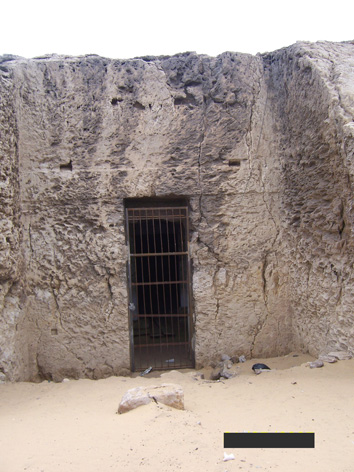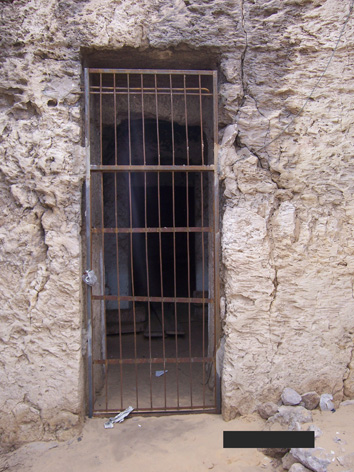![]()
![]()
GIZA'S
CAVE UNDERWORLD
SEALED SHUT
EGYPT'S CHIEF EGYPTOLOGIST CLOSES THE ENTRANCE TO THE CAVERNOUS REALM EXISTING BENEATH THE PYRAMIDS OF GIZA

The
new gate on the Tomb of the Birds (NC2) at Giza. Inside is the entrance to Giza's
cave underworld (pic credit: Larry Hunter, 2010)
Cairo: The entrance to Egypt's cave underworld has been sealed shut just two years after its modern day discovery. Access to the tomb leading to these natural caverns, located beneath the famous Pyramids of Giza, is now blocked by a metal gate set in concrete.
The move follows recent work to clear the interior of the tomb known as NC2 or the "Tomb of the Birds", and located in the plateau's north cliff.
This came in the wake of revelations in the press last summer that British explorer and writer Andrew Collins had in March 2008 located a previously unknown opening into a natural cave system long thought to exist at Giza, but never before explored in modern times.
The excavations inside the tomb - coordinated by Dr Zahi Hawass, Secretary General of Egypt's Supreme Council of Antiquities - uncovered a series of subterranean rooms and galleries thought to have been used in the past as a necropolis for the interment of bird mummies.
Despite these recent discoveries, Dr Hawass has publicly denied that any natural cave system extends from the tomb, stating that what exists beneath the ground are catacombs carved by human hands, something that Mr Collins disagrees with strongly.
"We have dozens of clear photos, along with film footage, that make it clear that extending from the Tomb of the Birds is an extensive series of cave passages that almost certainly reach beneath the main pyramid field," Collins said.
"These caverns are natural, and must not be confused with the subterranean galleries entered by Dr Hawass and his team, which are accessed elsewhere in the same tomb."
Collins backs up his claims by producing radar satellite imagery that shows geological faulting coinciding precisely with the position and orientation of the caves explored so far. This faulting is seen to extend hundreds of meters from the position of the tomb to beneath the plateau's Second Pyramid, the site of the fabled Cave-tomb of Hermes according to ancient Arab sources.
Collins's evidence is supported by the memoirs of British explorer Henry Salt who in 1817 records how he gained access to the same cave system, and explored them for a distance of "several hundred yards" before coming up four spacious chambers, from which went various labyrinthine passages.
With the sealing of the entrance to the tomb, any hope of further exploration in the caves now becomes impossible.
"It is sad that we won't be able to continue our investigations in the caves," Collins admitted. "Now only Dr Hawass's promised report on his clearance of the tomb can throw any further light on the caves, and their possible usage during an age even before the building of the pyramids some 4,500 years ago."
For
more information on the rediscovery of Giza's cave underworld, see Andrew Collins's
book Beneath the Pyramids (4th Dimension Press, Virginia Beach, VA, 2009).
![]()
THE
SEALING OF THE TOMB OF THE BIRDS -ITS GREATER IMPLICATIONS AND THOUGHTS FOR THE
FUTURE OF CAVE RESEARCH AT GIZA
A Report by Andrew Collins
The
above press statement was released on April 4th, 2010. The matter was brought
to my attention recently by correspondent Larry Hunter. He gained access to Giza's
north cliff, where the Tomb of the Birds is situated, on March 5th, and took a
series of revealing photos. The entrance to the tomb has been sealed in concrete
with the gate in position, preventing any access to the sepulchre, where Dr Hawass'
team had for several months been busy removing tonnes of debris both from the
tomb and its underground galleries. Indeed, planks and excavation equipment still
litter the floor, even though it is now sealed. Whether or not this is a permanent
fixture remains to be seen, for attached to the gate is a new lock, still in its
plastic bag, that might well be fitted in time. Yet to do this, the concrete casing
around the gate would have to be first removed.

A
close up of the gate now in place at the entrance to the Tomb of the Birds (NC
2) at Giza.
Note the lock in the plastic bag. (Pic credit: Larry Hunter, 2010).
In addition to the gate on tomb NC 2 (north cliff No. 2), i.e. the Tomb of the Birds, a similar gate has been placed on tomb NC1, located further along the cliff in the direction of the Great Pyramid, while a further gate was in March 2010 about to be put on a much smaller tomb, designed NC3, located a few hundred metres west of the Tomb of the Birds. It seems that the Supreme Council of Antiquities want to ensure that no one disturbs any of these tombs in the plateau's north cliff, which are all barely recorded in Egyptological terms.
Double
Edged Sword
The sealing of the Tomb of the Birds is a double edged sword. On the one hand it preserves the caves' delicate eco system, which includes a colony of bats, along with species of spiders and other types of large bugs, and protects for future generations any untouched archaeology the caves might contain. This includes fragments of mummies, and possibly even the last vestiges of primitive rock art.
On the other hand, the sealing of the caves now means that we are unable to continue our own investigations on site. I had hoped to return there, perhaps in the company of a geologist, who might have been able to throw better light on the nature of the caverns. However, this now seems impossible.
What
Lies Beyond the Stone Tube?
Whether or not the caves do reach the Second Pyramid, as the radar satellite imagery suggests, might now never be known. During our own explorations we came to a halt in a compartment beyond which was a narrow horizontal tube that appeared to connect with an even deeper section of the caves. Yet due to the stressful circumstances that had brought us to this moment, and the fact that my wife Sue had clearly heard something moving about beyond the tube, we had decided against venturing further.
Which
Bird Cult?
The future of the caves, and our knowledge regarding their past usage, is now in the hands of Dr Zahi Hawass. His people cleared the Tomb of the Birds and uncovered the entrances to lower galleries that would seem to have last been explored by Col. Richard Howard Vyse and his engineer friend, John Shae Perring, in 1837. We know that they came across evidence of the interment of bird mummies, and so it is hoped that Dr Hawass's team might be able to shed further light on this subject. Identifying what type of birds were interred might well provide some clue as to how the ancient Egyptians viewed the entrance to Giza's cave world. My money would be on the birds being either ibises, indicative of the cult of Thoth (the Greek Hermes), or falcons, suggestive of the cult of Horus or more intriguingly that of Sokar, the guardian of the Memphite necropolis in its role as the Fifth Hour of the duat-underworld as portrayed in the Am-duat funerary text. Other bird types might include the vulture, indicative of the cult of Mut; the goose, the totem of the earth-god Geb, the eagle, examples of which were found recently in a new tomb discovered at Saqqara, or even the crane, which might hint at a very archaic cult indeed.
My own intuition tells me that the key influence connected with the caves will always have some link to a primeval creator in the form of a bird and serpent. This seems borne out by the fact that local folklore states that el-kahf, "the caves", are thought to be the haunt of a great serpent called el-Hanash, and the presence here of a local bird cult.
A
Clue to the Dogon
Beyond this is my belief that to truly understand the influences anciently venerated inside the caves, we must look towards the animistic and totemic cults and ancestral myths of central Africa, like those that survive today in parts of the Sudan, Ethiopia and Kenya. It might even be important to look further a field to tribal peoples such as the Dogon of Mali, whose ancestors might easily have had contact via the sub-Sahara with the prehistoric races of the Nile Valley. As writer Laird Scratton persuasively demonstrates in his book The Science of the Dogon, there are tantalising links between the Dogon and ancient Egyptian creation myths, particularly those of Heliopolis and Hermopolis. Robert Bauval's upcoming book Black Genesis might also provide new clues regarding the African origins of ancient Egyptian religion.
Interestingly, the Bandagari Hills of Mali, where the Dogon live today, has produced evidence of the oldest pottery ever to be found in Africa. Dating back 12,400 years, it rivals even the earliest known pottery discovered in the Near East, the accepted cradle of civilization. Thus it is quite clear that advanced peoples existed in central and western Africa even before this age, offering the prospect that their beliefs might well have reached the Nile valley prior to the foundation of dynastic Egypt sometime around 3100 BC.
![]()
![]()